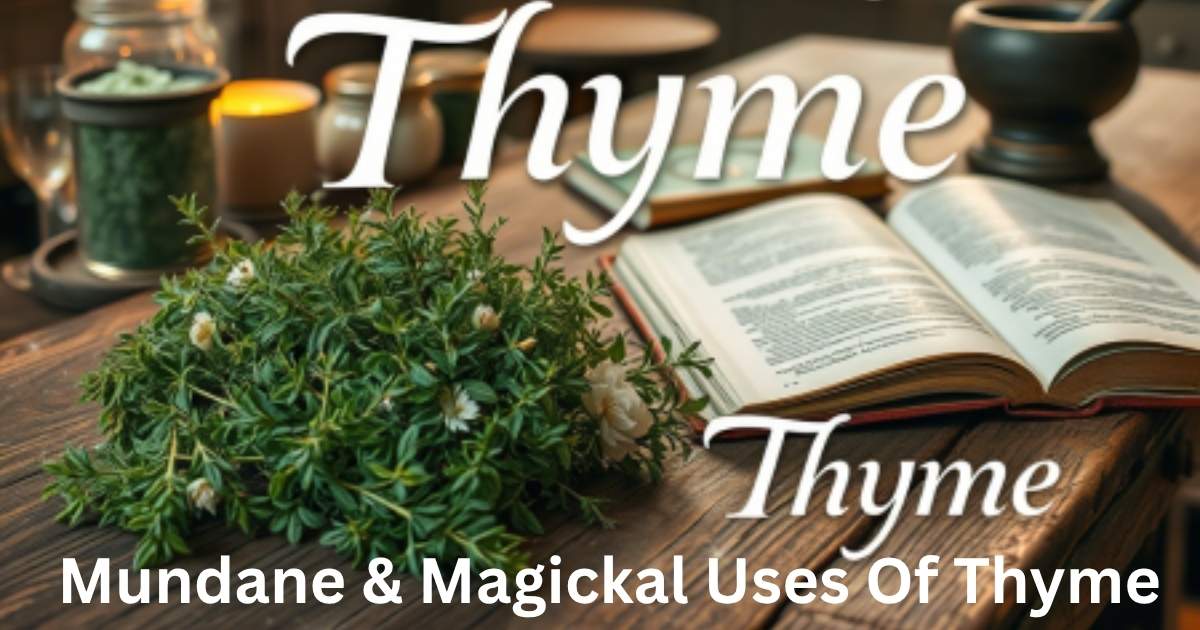Mundane & Magickal Uses Of Thyme
Thyme is more than just a kitchen herb; it’s a powerful plant filled with history, healing, and magic. For centuries, people have turned to thyme for its scent, flavor, and spiritual energy. While it’s often found in soups or roasted dishes, the uses of thyme reach far beyond the stove. This tiny leaf holds ancient wisdom and has been part of natural healing and sacred rituals across many cultures. The uses of thyme include its role in protection spells, dreamwork, and calming the spirit.
People also value the thyme spiritual meaning, connecting it to courage, peace, and emotional strength. With strong thyme magical properties and healing energy, it brings clarity and positivity. Many in modern thyme witchcraft use it in spell jars, oils, and incense. The magical properties of thyme and thyme metaphysical properties make it a must-have in both kitchen and ritual spaces. The uses of thyme truly bridge the everyday and the mystical.
Plant/herb – Thyme
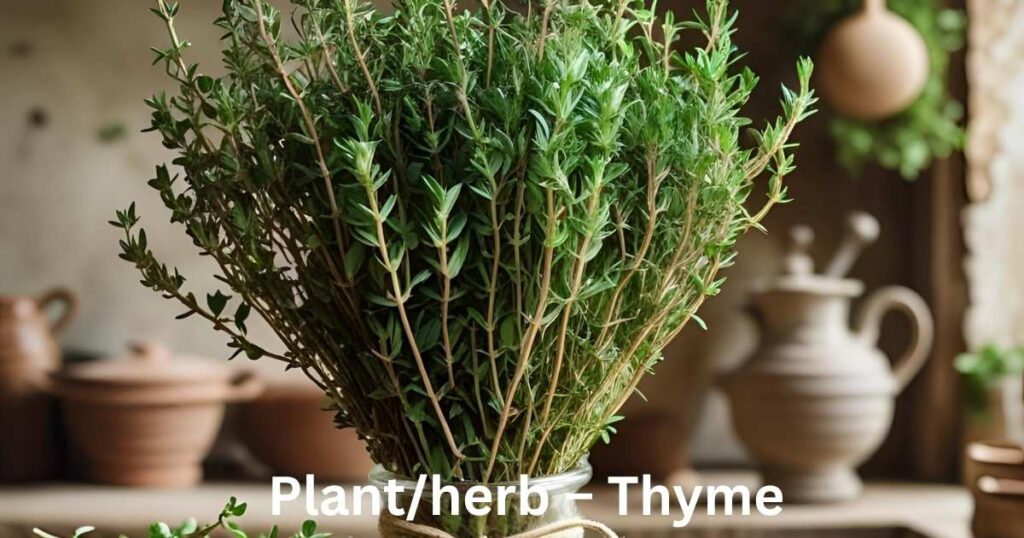
The use of thyme is a perennial herb, which means it grows back year after year. It’s small, green, and strong, with tiny leaves that hold a lot of flavor and power. You might already be using it in your cooking, but did you know thyme also helps with respiratory problems and brings protection in magical rituals? This small plant belongs to the Lamiaceae or Mint family, and its close cousin is oregano. Its name might come from a Greek word meaning “to fumigate,” which links to burning thyme as incense in old temples and homes.
In ancient times, people believed they had the power to make someone brave. Mars and Ares, both gods of war, were said to bless warriors with thyme for courage and bravery. During the Middle Ages, ladies would sew bees and thyme on scarves to give to knights. In British Isles folklore, it was said that if you washed your eyes with dew from thyme on the first of May, you could see faeries. That’s why thyme is also known for opening your psychic powers, helping in dreamwork, and bringing strong auras.
Cultivating Thyme
The use of thyme grows well in many places across the USA, especially in warm and sunny spots. You can plant it in a garden or even in a small pot on your window. It loves soil that drains well, with a pH between 6.0 and 8.0. Make sure it gets at least 4 hours of sunlight a day. Thyme doesn’t like too much water. Let the soil dry before watering again. That helps avoid root rot and keeps the plant healthy.
You can grow thyme from cuttings, seeds, or by dividing big plants. Try planting in spring or early summer. Give each plant about 12 to 18 inches of space so it can breathe and grow strong. If you’re growing thyme inside, place it near a sunny window. Use mulch to hold moisture and protect the roots. You can prune it regularly to keep it bushy. Just don’t cut the woody stems at the base. With care and time, your thyme will grow into a strong herbal friend, ready for both mundane and magickal uses.
1. Climate and Sunlight:
The use of thyme loves warm weather and needs lots of sun to grow well. It should get at least 6 hours of sunlight every day. Partial shade is okay, but full sun is best. If it doesn’t get enough light, it may grow slowly and lose its strong flavor.
2. Soil Needs:
Thyme likes dry, light soil that drains water easily. The soil should not stay wet, or the roots can rot. A pH between 6.0 and 8.0 is best. Sandy or rocky soil works well. Don’t use heavy or clay soil because it holds too much moisture.
3. Watering:
Thyme doesn’t need much water. Wait until the soil is dry before watering again. If you water too often, the roots can rot. During hot weather, water more often. In winter, there is less water. Always check the soil with your finger before adding more water.
4. Container Growing:
Thyme grows great in pots or containers. Use a pot with holes so water can drain out. Place the pot where it gets plenty of sun. You can bring the pot indoors during cold weather. Make sure the soil in the container doesn’t stay too wet.
5. Planting Time:
Spring is the best time to plant thyme. The weather should be warm, and there should be no more frost. Early summer is also good. If the weather is still too cold, the seeds or cuttings may not grow well. Wait for a stable warm temperature.
6. Growing from Seeds:
You can grow thyme from seeds, but it takes time. The seeds are small and slow to sprout. Keep the soil moist but not wet. Put them in a sunny, warm place. It may take 2 to 3 weeks to see small green shoots appear.
7. Using Cuttings:
Taking cuttings from an older thyme plant is an easy way to grow new ones. Cut a healthy stem and place it in moist soil. Keep it in a sunny spot and water lightly. After a few weeks, roots will form, and a new plant will grow.
8. Space Between Plants:
When planting them, give each plant some space. They need about 12 to 18 inches apart to grow wide and strong. If you plant them too close, they might not get enough air or sunlight. Space helps the plants stay healthy and free from disease.
9. Feeding:
Thyme does not need much food. Adding a small amount of compost or organic fertilizer once a year is enough. Too much feeding can actually harm the flavor. If the soil is poor, just mix in a little compost before planting. Keep it simple and light.
10. Pest Control:
Thyme naturally keeps most bugs away because of its strong smell. You usually won’t need pesticides. If you see pests, pick them off or spray them with water. Don’t use strong chemicals, as they can harm the plant. Thyme is very good at protecting itself from pests.
Harvesting and Drying Thyme:
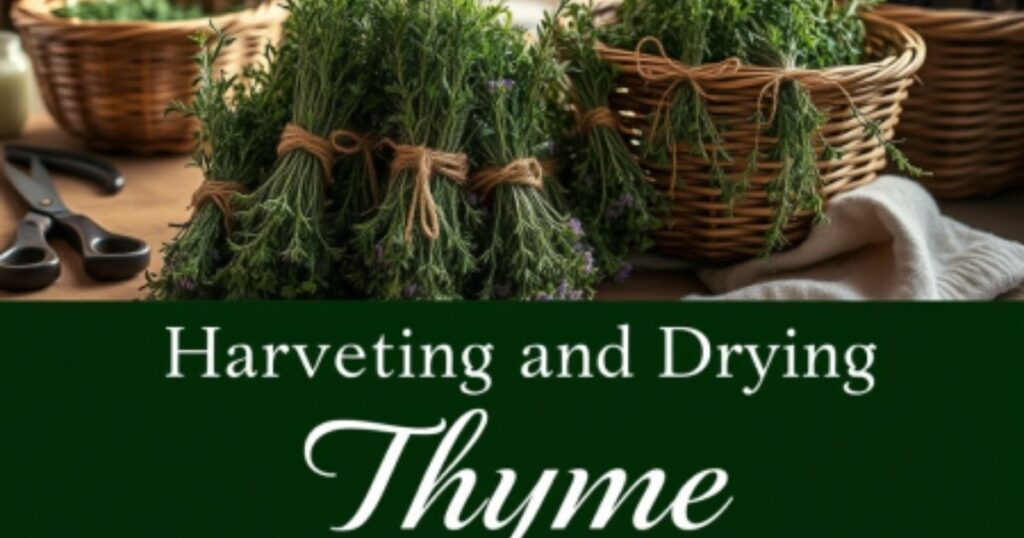
Harvesting thyme is easy and peaceful. Wait until your plant is at least 6 inches tall. Then, using clean scissors, cut the stems above a leaf pair. Morning is best because that’s when the essential oil is strongest. Try not to cut too much at once. The plant needs its leaves to stay alive. Harvest only what you need for the day, or a bit extra if you plan to dry it.
To dry thyme, tie a few sprigs together and hang them upside down in a dry place with good air. You can also dry it using a dehydrator or low heat in your oven. Once it’s dry, rub the leaves off the stem and store them in an airtight jar. Keep the jar in a cool, dark space. Dried thyme stays fresh for several months and can be used in herbal tea, cooking, or spell jars. When dried and stored properly, it keeps its flavor and magickal energy strong.
- 1. Timing:
You can start harvesting thyme once the plant is strong and at least 6 inches tall. This usually happens after a few months of growth. Make sure it has enough leaves to recover. Harvesting too early can stress the plant and stop it from growing well later. - 2. Method:
Use clean scissors or garden shears to cut the thyme. Always cut just above a set of leaves to help new growth come back fast. Pick in the early morning when the plant’s oils are strongest. Avoid harvesting during or after rain, as wet thyme is harder to dry. - 3. Best Season:
The best time to harvest thyme is in the late spring or early summer, right before it flowers. This is when it holds the most flavor and oil. Try not to wait too long, because the flavor becomes weaker after the plant blooms and goes into seed. - 4. Frequency:
You can harvest thyme several times a season if the plant is healthy. After each harvest, let it grow back before cutting again. Give it two to three weeks between harvests. Don’t over-harvest, or the plant might become thin, weak, and stop growing new healthy leaves. - 5. Drying Time:
Thyme usually takes about 1 to 2 weeks to dry fully, depending on the weather. Keep it in a warm, dry place with air flow. If it feels crisp and crumbles easily, it’s ready. Don’t rush the drying process or you might lose flavor and aroma. - 6. Drying Method (Air):
Tie thyme stems into small bunches and hang them upside down in a dark, dry place. Make sure the area has good air movement. Avoid direct sunlight, which can weaken the oils. Hang in a closet, pantry, or anywhere warm but out of light and moisture. - 7. Drying Method (Oven):
To dry thyme faster, spread it on a baking sheet and place it in the oven on the lowest heat setting. Leave the door slightly open for airflow. Check every 10 minutes. Remove when the leaves feel dry and brittle. Don’t overcook, or they’ll lose their scent. - 8. Storage:
Once thyme is dry, remove the leaves from the stems and place them in an airtight container. Keep the container in a cool, dark cupboard. Glass jars work best. Avoid plastic bags, which can trap moisture. Proper storage helps them keep their taste and scent for many months. - 9. Fresh Use Option:
If you don’t want to dry thyme, you can also use it fresh. Just rinse it gently and pat dry. Add to food or tea right away. Fresh thyme has a stronger flavor than dried thyme, so you may need to use a little less when cooking. - 10. Label and Date:
Always label your thyme with the date you dried it. Herbs lose strength over time. It’s best to use dried thyme within 6 to 12 months. After that, the color fades and the scent weakens. Keeping track helps make sure your herbs stay strong and useful.
Mundane Uses of Thyme:
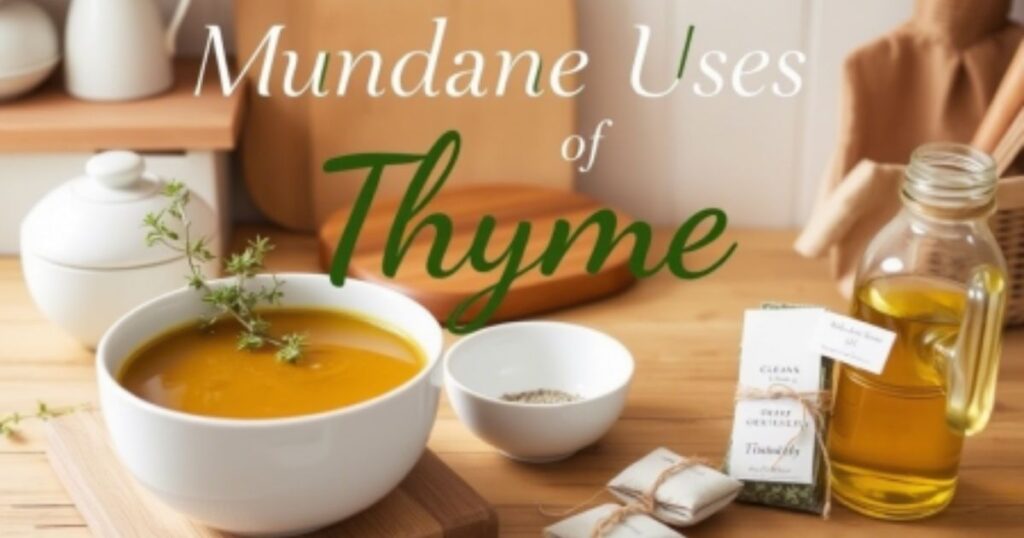
uses of thyme every day in American homes. You’ll find it in kitchens, baths, and even cleaning sprays. It brings a strong aroma, helps with digestion, and makes a great natural antibacterial cleaner. Add it to homemade cleaners for a fresh smell and a touch of nature in your space. You can also place thyme in small sachets and tuck them into drawers to keep clothes smelling fresh.
It’s common to use thyme when someone has a cold or sore throat. You can make a tincture, balm, or thyme tea to help ease the symptoms. A steam bath using thyme is great for the lungs and can even help with shortness of breath. Some believe thyme helps clear the subconscious and brings clarity, which is why many people use it during times of stress, grief, or fatigue. Its uses are many, and its power lies in both the physical and the emotional world.
Culinary Uses:
In cooking, thyme is loved for its warm, earthy flavor. It’s often used in American dishes like roasted chicken, soups, and stews. It adds a special taste to potatoes, carrots, tomatoes, and other vegetables. You can use it fresh or dried. Just remember, dried thyme is stronger, so use a little less. In the South, thyme is often added to meat rubs or mixed with rosemary and marjoram in herbes de Provence.
Some people add thyme to butter, oil, or even bread dough. You can also make a thyme-infused vinegar or dressing for salads. Try it in eggs, cheese dishes, or even with seafood like shrimp and salmon. Thyme makes your food not just taste better, but feel more magical. Cooking with thyme is a form of kitchen witchcraft, where food becomes a spell that gives energy, love, and healing.
1. Seasonings:
The use of thyme is a key part of seasoning mixes like Herbes de Provence and Italian blends. It pairs nicely with rosemary, sage, and oregano. Its earthy, slightly minty flavor enhances meat rubs, roasted vegetables, and savory snacks. Crushed dried thyme or fresh leaves work equally well in cooking.
2. Soups and Stews:
Thyme adds depth to soups, stews, and broths. It blends beautifully with onions, garlic, and root vegetables. Whether you’re cooking chicken soup, beef stew, or lentil broth, thyme lifts the flavor. It works with both meat-based and plant-based dishes, especially during slow-cooked recipes for fuller taste.
3. Roasted Dishes:
Add thyme to roasted meats like chicken, beef, or lamb for added flavor. It also works great with roasted potatoes, carrots, and squash. Just sprinkle fresh or dried thyme over your dish before baking. The warmth of the oven helps release thyme’s oils and enhances the aroma.
4. Marinades and Rubs:
Use thyme in marinades for chicken, beef, or fish. Combine it with olive oil, lemon, garlic, and salt for a tasty blend. You can also use dried thyme in spice rubs. It adds a woodsy note and helps season the meat evenly before cooking or grilling.
5. Pasta Dishes:
Thyme brings flavor to creamy or tomato-based pasta sauces. It complements garlic, basil, and cheese perfectly. Try adding thyme to Alfredo, marinara, or mushroom sauces. A small pinch goes a long way, giving your pasta dish a comforting and earthy flavor that makes it more enjoyable.
6. Bread and Doughs:
Add thyme to bread dough or sprinkle it on top before baking for extra taste. It works well in flatbreads, focaccia, and biscuits. You can also mix it into garlic butter for spreading. The herb’s strong scent and flavor shine in baked goods, giving them a rustic touch.
7. Grilled Vegetables:
Thyme pairs wonderfully with grilled vegetables like zucchini, eggplant, peppers, and mushrooms. Toss veggies in olive oil, garlic, and thyme before grilling. The heat brings out thyme’s aroma and blends with the smoky flavor. It’s a healthy, flavorful way to enjoy simple veggies with minimal effort.
8. Omelets and Eggs:
Sprinkle thyme into scrambled eggs or omelets for added flavor. It pairs well with cheese, spinach, and tomatoes. Thyme gives a simple egg dish a nice herbal taste and can make your breakfast feel more gourmet. Use fresh thyme leaves or a pinch of dried thyme.
9. Cheese and Butter:
Mix thyme into soft cheese spreads or compound butter for added depth. It works well with goat cheese, cream cheese, and even hard cheeses. You can make herbed butter by blending thyme with garlic and parsley, then using it on bread, vegetables, or meats.
10. Pizza and Flatbreads:
Thyme adds extra flavor to homemade pizzas or flatbreads. Sprinkle it over tomato sauce, cheese, or vegetables before baking. It works especially well with mushrooms, caramelized onions, and goat cheese. The herb’s scent fills the kitchen and gives your pizza a lovely herbal boost.
11. Rice and Grains:
Add thyme to rice, quinoa, or couscous while they cook. It pairs well with vegetable broth and adds depth to plain grains. You can also use thyme when making pilafs or savory oatmeal. It’s a simple way to make your side dish more flavorful and comforting.
12. Salads and Dressings:
Chop fresh thyme into salad dressings for an herby flavor. It goes well with lemon, honey, mustard, and olive oil. You can also toss thyme leaves directly into green salads. It gives fresh salads a mild, woodsy kick and balances stronger flavors like cheese or vinegar.
13. Sauces and Gravies:
Add thyme when making sauces or gravies. It complements mushroom gravy, onion sauce, and meat-based reductions. Just a pinch of thyme gives sauce more complexity without overpowering it. Use it in combination with black pepper and garlic for an extra-rich, comforting flavor in savory sauces.
14. Pickling and Preserving:
Thyme is great in pickles and preserves. Add it to jars of pickled cucumbers, onions, or carrots for extra flavor. You can also include it in infused oils or vinegars. Its antibacterial properties help preserve food and enhance the taste of homemade condiments and spreads.
15. Infused Drinks:
Steep thyme in hot water to make herbal tea. You can also add it to lemonade or cocktails for a unique twist. Thyme pairs well with honey, lemon, and mint. Its earthy taste adds balance and freshness to both hot and cold drinks, especially in summer.1. Seasonings:
Thyme is a key part of seasoning mixes like Herbes de Provence and Italian blends. It pairs nicely with rosemary, sage, and oregano. Its earthy, slightly minty flavor enhances meat rubs, roasted vegetables, and savory snacks. Crushed dried thyme or fresh leaves work equally well in cooking.
2. Soups and Stews:
Thyme adds depth to soups, stews, and broths. It blends beautifully with onions, garlic, and root vegetables. Whether you’re cooking chicken soup, beef stew, or lentil broth, thyme lifts the flavor. It works with both meat-based and plant-based dishes, especially during slow-cooked recipes for fuller taste.
3. Roasted Dishes:
Add thyme to roasted meats like chicken, beef, or lamb for added flavor. It also works great with roasted potatoes, carrots, and squash. Just sprinkle fresh or dried thyme over your dish before baking. The warmth of the oven helps release thyme’s oils and enhances the aroma.
4. Marinades and Rubs:
Use thyme in marinades for chicken, beef, or fish. Combine it with olive oil, lemon, garlic, and salt for a tasty blend. You can also use dried thyme in spice rubs. It adds a woodsy note and helps season the meat evenly before cooking or grilling.
5. Pasta Dishes:
Thyme brings flavor to creamy or tomato-based pasta sauces. It complements garlic, basil, and cheese perfectly. Try adding thyme to Alfredo, marinara, or mushroom sauces. A small pinch goes a long way, giving your pasta dish a comforting and earthy flavor that makes it more enjoyable.
6. Bread and Doughs:
Add thyme to bread dough or sprinkle it on top before baking for extra taste. It works well in flatbreads, focaccia, and biscuits. You can also mix it into garlic butter for spreading. The herb’s strong scent and flavor shine in baked goods, giving them a rustic touch.
7. Grilled Vegetables:
Thyme pairs wonderfully with grilled vegetables like zucchini, eggplant, peppers, and mushrooms. Toss veggies in olive oil, garlic, and thyme before grilling. The heat brings out thyme’s aroma and blends with the smoky flavor. It’s a healthy, flavorful way to enjoy simple veggies with minimal effort.
8. Omelets and Eggs:
Sprinkle thyme into scrambled eggs or omelets for added flavor. It pairs well with cheese, spinach, and tomatoes. Thyme gives a simple egg dish a nice herbal taste and can make your breakfast feel more gourmet. Use fresh thyme leaves or a pinch of dried thyme.
9. Cheese and Butter:
Mix thyme into soft cheese spreads or compound butter for added depth. It works well with goat cheese, cream cheese, and even hard cheeses. You can make herbed butter by blending thyme with garlic and parsley, then using it on bread, vegetables, or meats.
10. Pizza and Flatbreads:
Thyme adds extra flavor to homemade pizzas or flatbreads. Sprinkle it over tomato sauce, cheese, or vegetables before baking. It works especially well with mushrooms, caramelized onions, and goat cheese. The herb’s scent fills the kitchen and gives your pizza a lovely herbal boost.
11. Rice and Grains:
Add thyme to rice, quinoa, or couscous while they cook. It pairs well with vegetable broth and adds depth to plain grains. You can also use thyme when making pilafs or savory oatmeal. It’s a simple way to make your side dish more flavorful and comforting.
12. Salads and Dressings:
Chop fresh thyme into salad dressings for an herby flavor. It goes well with lemon, honey, mustard, and olive oil. You can also toss thyme leaves directly into green salads. It gives fresh salads a mild, woodsy kick and balances stronger flavors like cheese or vinegar.
13. Sauces and Gravies:
Add thyme when making sauces or gravies. It complements mushroom gravy, onion sauce, and meat-based reductions. Just a pinch of thyme gives sauce more complexity without overpowering it. Use it in combination with black pepper and garlic for an extra-rich, comforting flavor in savory sauces.
14. Pickling and Preserving:
Thyme is great in pickles and preserves. Add it to jars of pickled cucumbers, onions, or carrots for extra flavor. You can also include it in infused oils or vinegars. Its antibacterial properties help preserve food and enhance the taste of homemade condiments and spreads.
15. Infused Drinks:
Steep thyme in hot water to make herbal tea. You can also add it to lemonade or cocktails for a unique twist. Thyme pairs well with honey, lemon, and mint. Its earthy taste adds balance and freshness to both hot and cold drinks, especially in summer.
Aromatic Uses:

The smell of thyme is calming and strong. It’s used in aromatherapy to help with anxiety and mental focus. Just a few drops of thyme essential oil in a diffuser can fill your room with warmth and clarity. You can also make your own incense or add dried thyme to a potpourri mix. These smells help create a sacred space in your home.
If you like DIY, try making a sachet, drawer liner, or room spray using thyme. Burning thyme as incense in an incense burner helps clear bad energy and raise your room’s vibration. You can also add thyme to bath water, turning a simple soak into a herbal bath for the soul. Many people use thyme candles or wax melts for a cozy, magical mood. These simple things bring peace and spiritual balance to your space.
1. Potpourri
- Dried thyme adds a fresh, herbal smell to potpourri.
- It blends well with flowers and dried fruits.
- Keeps the mix smelling natural and pleasant.
- Helps freshen rooms without chemicals.
2. Sachets and Drawer Liners
- Fill small cloth bags with dried thyme.
- Put them in drawers or closets.
- Thyme gives clothes a nice, fresh scent.
- It helps protect against moths and insects.
3. Room Sprays
- Mix thyme with water and a little alcohol.
- Spray it in rooms for a clean smell.
- It’s natural and easy to make.
- Great for kitchens and bathrooms.
4. Incense Blends
- Combine thyme with resin or other herbs.
- Burn it in an incense burner.
- Produces a warm, woodsy scent.
- Ideal for calming and energy clearing.
5. Essential Oil Diffusing
- Add a few drops of thyme oil to a diffuser.
- Helps boost energy and focus.
- Fills the room with a fresh, clean aroma.
- Can ease stress and tension.
6. Candle Making
- Mix dried thyme into wax before pouring.
- Or sprinkle on top of candles.
- Makes candles look and smell lovely.
- Adds a natural, herbal scent to your home.
7. Wax Melts
- Add thyme to wax melt cubes.
- Heat them in a warmer aroma.
- Creates a gentle, herbal fragrance.
- Perfect for small rooms and offices.
8. Herbal Infusion Sprays
- Steep thyme in hot water or vinegar.
- Strain and pour into a spray bottle.
- Use as a room or linen spray.
- Refreshes air naturally and easily.
9. Carpet Freshener
- Mix dried thyme with baking soda.
- Sprinkle on carpet before vacuuming.
- Removes odors and freshens the room.
- A natural and cheap solution.
10. Bath Sachets
- Tie thyme in a cloth bag.
- Let it steep in bath water.
- Gives a relaxing herbal scent.
- Helps soothe muscles and calm the mind.
11. Pillow Sachets
- Fill a small bag with dried thyme.
- Place it under or near the pillow.
- Helps promote easy, restful sleep.
- Can bring calm and peaceful dreams.
12. Car Freshener
- Put dried thyme in a small jar or cloth bag.
- Leave it in your car.
- Keeps the car smelling fresh.
- A natural alternative to commercial scents.
Read this Also: Eye of Horus Symbol Meaning – Eye of Horus Facts
Medicinal Uses:
The use of thyme has long been used as a natural medicine. It contains thymol, which has strong antimicrobial, antifungal, and antibacterial powers. It helps fight infections and can be used for skincare, like clearing up acne or healing cuts. Many people use thyme in poultices, salves, and topical oils to ease skin problems or sore muscles.
If you have a cough or cold, thyme tea works as an expectorant. It loosens mucus and makes breathing easier. It’s also antispasmodic, so it helps with cramps and menstrual pain. Some say thyme improves circulation, helps the immune system, and even supports memory and psychic development. But always check with a doctor before using thyme for health reasons, especially if you are pregnant or have high blood pressure.
1. Antimicrobial Properties
- Thyme has a strong compound called thymol.
- Thymol can fight bacteria and fungi.
- Often used in natural mouthwashes and cleaners.
- Helps prevent infection and supports healing.
2. Respiratory Health
- uses of thyme can help clear coughs and mucus.
- It works as a natural expectorant.
- uses of thyme tea and steam are used for breathing problems.
- It’s good for sore throats and lung strength.
3. Digestive Support
- Thyme helps with gas and bloating.
- It can relax stomach muscles.
- The use of thyme tea supports smooth digestion.
- Often used for cramps and indigestion.
4. Immune Booster
- Thyme supports the immune system naturally.
- It’s full of antioxidants that fight sickness.
- Drinking thyme tea may help during the cold season.
- Helps the body fight infections.
5. Skin Health
- uses of thyme can fight skin bacteria.
- It helps with acne and small cuts.
- Thyme oil is used in natural creams.
- Supports clean, clear skin naturally.
6. Anti-Inflammatory Effects
- Use of thyme may reduce swelling and pain.
- Helpful for sore muscles and joints.
- Used in balms or bath soaks.
- Supports comfort for arthritis and strain.
7. Fungal Infections
- Thyme oil helps fight fungus.
- Used on athlete’s foot and nail issues.
- Natural remedy for yeast infections.
- Must be diluted before applying on skin.
8. Stress and Anxiety Relief
- Thyme’s scent can calm the mind.
- Used in oils or teas for relaxation.
- May help reduce anxiety and tension.
- Works well with lavender and lemon balm.
9. Sleep Aid
- Thyme helps relax the body.
- Drinking thyme tea before bed supports rest.
- Used in pillow sachets for better sleep.
- May help reduce night-time coughing too.
10. Menstrual Relief
- Thyme can ease period pain.
- It helps relax the uterus.
- The use of thyme tea is a natural way to find relief.
- Used in herbal remedies for cramps.
11. Headache Relief
- Use of thyme oil helps ease headaches.
- Inhaling thyme steam may soothe pressure.
- Rubbing diluted oil on temples can help.
- Reduces tension and clears the mind.
12. Mouth Health
- Thyme fights germs in the mouth.
- Found in natural toothpaste and rinses.
- Helps freshen breath and soothe gums.
- Great for oral care without harsh chemicals.
13. Circulation Support
- Thyme helps improve blood flow.
- Used in massage oils for cold hands or feet.
- Stimulates warmth and comfort.
- Supports better overall circulation.
14. Cough Syrups and Lozenges
- The use of thyme is added to natural cough syrups.
- Eases dry or sore throats.
- Soothes irritation and helps clear mucus.
- Found in herbal throat drops too.
15. Thyme Tea Benefits
- Thyme tea supports overall wellness.
- Easy to make and good for daily use.
- Helps with digestion, breathing, and calming.
- A comforting herbal drink for health.
The Magickal Properties Of Thyme:

The use of thyme has strong roots in folk magic. People have used it for thousands of years for purification, protection, love, and healing. Thyme is linked to the planet Venus and the elements Air and Water. It’s believed to open your heart, bring restfulness, and invite in the fae. In the book Plant Witchery by Diaz, thyme is called a sacred herb of the goddess and the earth.
In witchcraft, thyme is burned to remove bad energy and attract good luck. It is used in divination, spellcasting, and to boost confidence and vision. Some say thyme placed under your pillow brings prophetic dreams. Others wear it in their hair or clothes to feel more beautiful and draw in attraction. From Our Lady’s Bedstraw to Jesus’ manger, thyme’s spiritual meaning runs deep in European and American traditions.
1. Protection from Negative Energy
Thyme has been used in spells to keep bad energy away. People burn dried thyme or carry it in a pouch for safety. It’s believed to protect the home, body, and spirit. Many say thyme creates a shield against evil, bad luck, and harmful spirits during magical rituals.
2. Cleansing and Purification
Thyme is known for its cleansing powers. People use thyme smoke to clean spaces, tools, or crystals. It clears out heavy or dark energy. You can burn thyme like incense or add it to a cleaning spray. It helps bring a fresh and light feeling into your sacred space.
3. Courage and Confidence Spells
Thyme is often used to bring bravery. Soldiers in ancient times carried it for courage. Today, people use them in charm bags or baths before big events. It helps you feel strong and bold. Thyme magic supports inner strength when facing fear, change, or speaking your truth confidently.
4. Attracting Love and Beauty
Thyme is a gentle love herb. It’s used in beauty spells and love sachets. People believe thyme brings kindness, charm, and soft energy that draws love. You can place them under your pillow or in your bath. It supports peaceful love and strengthens emotional connection in romantic relationships.
5. Luck and Prosperity
Thyme is used to bring good luck and money. Some keep them in their wallets or burn them with green candles. It’s believed to open doors to success and fortune. Magical users say it invites steady income, positive chances, and helps with financial growth and happy opportunities in life.
6. Dreamwork and Sleep Magic
Thyme supports restful sleep and sweet dreams. People stuff it into dream pillows or place it near their bed. It protects against nightmares and helps remember dreams. It’s great for dreamwork or astral travel. Thyme’s energy is soft and soothing, perfect for peaceful nights and spiritual dream exploration.
7. Connection with the Fae
Thyme has strong ties to faeries and nature spirits. Many believe planting thyme in your garden invites the fae. It’s seen as a sacred herb for fairy magic. You can leave thyme offerings to make contact or ask for blessings. Fae magic often works gently and brings joyful surprises.
8. Magical Beauty Enhancer
Thyme is believed to boost personal charm. In ancient times, women wore them to feel beautiful and loved. It’s used in beauty potions and bath spells today. Thyme helps you glow with natural energy. It’s said to increase attraction and confidence, especially in self-love and personal care rituals.
9. Psychic and Intuitive Boost
Thyme supports psychic growth and focus. People burn thyme during meditation or divination. It helps open the third eye and build trust in intuition. When working with tarot or spirit guides, thyme clears the mind. It’s helpful for those practicing clairvoyance, visions, or other spiritual connection practices.
10. Energy and Motivation Spells
Thyme is used to boost energy when you feel tired or stuck. Add it to a candle spell or wear it in a pouch. It lifts the spirit and wakes the mind. Its fire energy brings action, movement, and courage to get things done with a positive mindset.
11. Healing and Emotional Support
Thyme is a great herb for emotional healing. It brings calm to the heart and mind. People use it in bath magic or healing sachets. It helps release sadness, grief, and stress. Thyme’s gentle energy brings comfort, balance, and peace when you’re feeling overwhelmed or emotionally heavy.
12. Rituals for Renewal and Release
Thyme supports letting go of old energy. Use it in smoke cleanses, or burn it in rituals for endings. It helps you move on and start fresh. People use thyme to close chapters, clear their energy, and step into a new phase with more clarity, strength, and purpose.
13. Magical Cleansing Baths
Thyme is a favorite for ritual baths. Add dried thyme or thyme oil to warm water. It washes away stress and bad energy. This magical soak helps you feel calm, safe, and spiritually clean. It’s a good step before spells or meditation to ground yourself and recharge your spirit.
14. Sacred Space Cleansing
People burn thyme in incense burners to clean their space. It clears old or heavy vibes from a room. Thyme prepares the area for rituals or prayer. You can also hang thyme bundles near windows or doors. Its energy brings peace, clarity, and keeps the spiritual space fresh.
15. Spell Jars and Charm Bags
Thyme is common in spell jars and sachets. Add it with other herbs for love, money, or protection. It blends well with rosemary, lavender, or mint. These charms are carried in a pocket, purse, or under a pillow. Thyme’s magic works gently and adds powerful support to your spells.
How To Use Thyme For Magick
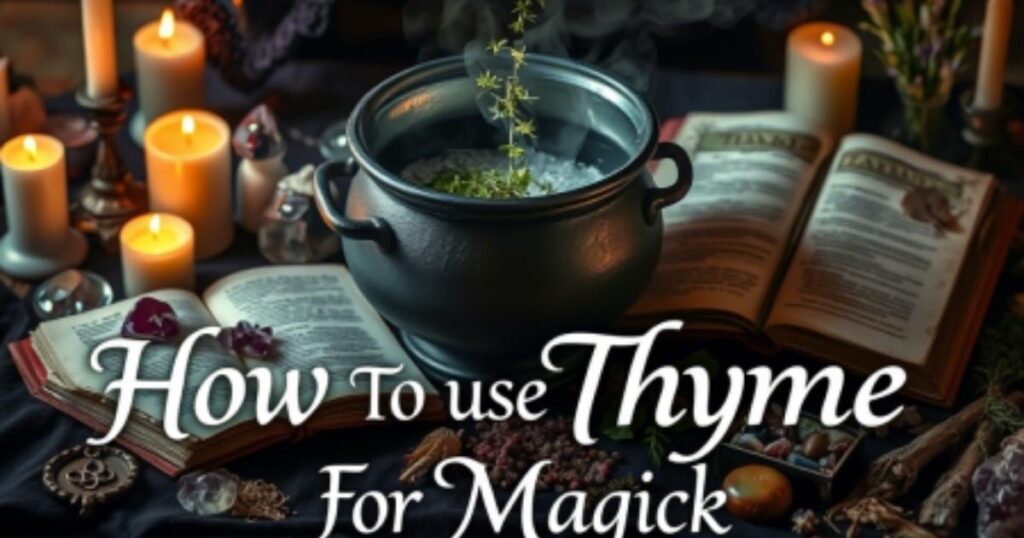
The use of thyme in magickal practice is simple and powerful. You can burn dried thyme on a charcoal disk to clean your space before doing a ritual. You can also bundle it with rosemary to make a smudge stick. Place dried thyme in a small sachet or spell jar and keep it in your bag, on your altar, or under your pillow for protection, courage, or sweet dreams.
For energy clearing, you can add thyme to a spring bath, helping to wash away sadness and welcome joy. A healing poppet stuffed with thyme is often used for emotional or physical healing. If you want to see the Fair Folk or connect to your intuition, wear or drink thyme during Litha or lunar rituals. Sprinkle it in doorways or grow it near your home to keep bad energy away. Simple acts like these can fill your daily life with magic and peace.
1. Burn for Protection
Burn dried thyme like incense to keep away bad energy and spirits from your home or space.
2. Add to Bath Water
Put thyme in warm bath water. It helps clean your energy and bring peace to your mind and body.
3. Carry in a Pouch
Keep dried thyme in a small cloth pouch in your pocket or bag. It brings courage, luck, and protection.
4. Place Under Pillow
Place thyme under your pillow to help you sleep better and have sweet, peaceful dreams.
5. Use in a Spell Jar
Mix thyme with other herbs in a small jar for love, luck, or money spells. Seal and keep near.
6. Sprinkle in a Circle
Sprinkle thyme in a circle around you for safe spellwork or meditation. It makes a strong spiritual shield.
7. Burn with Candles
Burn thyme with a green or red candle. It boosts money or love spells, depending on your wish.
8. Clean Tools with Thyme Smoke
Wave thyme smoke over your crystals or tarot cards to remove bad energy and reset them.
9. Use in Dream Pillows
Sew thyme into a small pillow and sleep with it. It brings messages through dreams and protects the spirit.
10. Drink Thyme Tea Before Rituals
Drink thyme tea before doing magic. It helps you feel calm, clear, and ready for spiritual work.
11. Hang Over Door
Hang a bundle of thyme over your front door. It keeps away evil and brings good vibes to your home.
12. Wash Floors with Thyme Water
Boil thyme in water and use it to wash your floors. It cleanses energy and brings blessings to your home.
13. Use in Love Spells
Add thyme to love spells or charms. It brings warm feelings, trust, and peaceful romance.
14. Decorate Altar with Fresh Thyme
Place thyme on your altar during rituals. It invites helpful spirits and adds healing energy.
15. Use for Faerie Magic
Leave them in your garden or under a tree. It invites fake spirits and nature magic.
16. Rub on Hands Before Spellwork
Rub thyme oil or dried thyme on your hands before casting spells. It strengthens your magical touch.
17. Write Wishes on Thyme Leaves
Write a wish on a thyme leaf and burn it safely. People believe it helps the wish come true.
18. Blend into Magical Oils
Infuse thyme in oil for use in spells, candle anointing, or energy work. It adds strong protective power.
19. Meditate with Thyme Nearby
Keep a bowl of dried thyme near during meditation. It helps you feel calm and focused on your thoughts.
20. Use in Full Moon Rituals
Add thyme to your full moon altar or bath. It boosts intuition, helps let go of old pain, and opens new paths.
FAQ’s
What is thyme for spiritually?
Thyme is used for spiritual cleansing, protection, and healing. Many believe the uses of thyme help raise energy and clear negative vibes.
What does the herb thyme symbolize?
Thyme symbolizes courage, love, and purity. In many cultures, the uses of thyme are tied to bravery, spiritual strength, and peaceful dreams.
What does thyme mean in the Bible?
In the Bible, thyme represents sacredness and was used for cleansing. Biblical uses of thyme were for holy rituals, purification, and divine blessings.
What chakra does thyme represent?
Thyme connects to the heart chakra, bringing love and emotional healing. The spiritual uses of thyme open the heart and restore peaceful energy.
What are magical uses of thyme?
The magical uses of thyme include dreamwork, attracting love, and psychic protection. It’s also burned in rituals to invite courage and sacred spiritual power.
Conclusion
The uses of thyme go far beyond cooking. This small herb holds deep power in both everyday life and spiritual practice. People have used it for healing, flavor, and energy for centuries. The thyme spiritual meaning connects to courage, strength, and peace. In many cultures, thyme brings calm and clears away bad energy. It’s also known to protect your space and body.
The thyme’s magical properties are strong but gentle. The magical properties of thyme help with dreams, love, and focus. Many use it in spells and rituals. The thyme metaphysical properties support psychic work and emotional healing. In thyme witchcraft, it’s burned as incense, added to baths, and placed in charm bags. Whether you drink it as tea or use it in a spell jar, the uses of thyme are powerful and simple. This herb is a gift from nature and a true tool for mind, body, and spirit.

Spiritual Lume is a trusted spiritual blog dedicated to exploring the deeper meanings of life, dreams, and divine signs. We offer thoughtful interpretations of symbols, Bible verses, and spiritual concepts to guide readers on their personal and spiritual journey. At https://spirituallume.com, our mission is to illuminate your path with wisdom, faith, and clarity.

